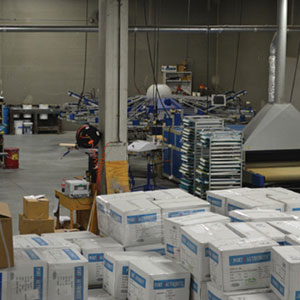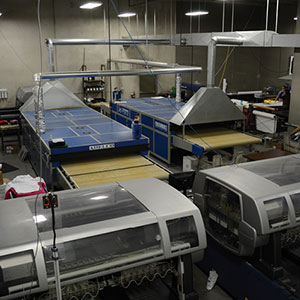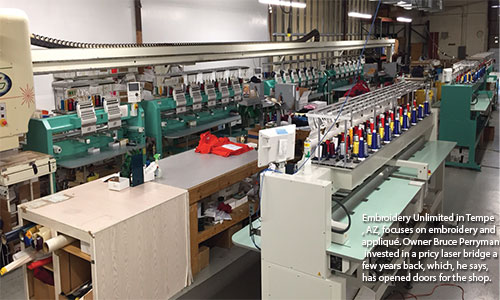Product Hub June 08, 2015
Expand and Contract
Despite dealing with low margins and high pressure, a number of decorators still thrive by eschewing direct sales and focusing only on contract work.
Stitch Designers (asi/741145) in Louisville, KY, was so busy at the end of 2014 that the shop had to cut off holiday orders at the beginning of December, its production staff working 12-hour shifts, seven days a week to process 3,000 jobs in time for Christmas – a tall order even for a shop used to taking on tall orders. “We got every single one delivered,”says Tracey Tyree, national accounts manager. “If we tell you that we’re going to get it done, we’re going to get it done.”
Dubow Textile in St. Cloud, MN, consists of about 160 embroidery heads, four industrial direct-to-garment printers, several screen-printing presses and more. The contract shop continues to expand, recently ordering five more eight-head embroidery machines, according to owner Rob Dubow.
Welcome to the world of contract decorating, where the stakes are high and the margins are slim. Basing your profits solely on the power of your stitches, rather than the markup you can charge for selling the apparel itself, isn’t for the faint of heart. As Bruce Perryman, CEO of Tempe, AZ-based Embroidery Unlimited quips: “Mama, don’t let your babies grow up to be contract decorators.”
And these days, with order sizes shrinking and competition from suppliers with in-house decoration growing, it’s harder than ever to make it on contract decorating alone. Still, there are plenty of shops meeting those challenges head on, surviving and, indeed, thriving in the ever-shifting market, without compromising their core values. “It’s a very hard business, but once you figure it out, you’re the master of your own domain,”says Marshall Atkinson, chief operating officer at Visual Impressions in Milwaukee.


1. Dubow Textile in St. Cloud, MN, has two automatic screen-printing presses as well as a handful of manuals.
2. Heat transfer is another decoration method offered by Dubow Textile. The contractor offers “all the services that are required for any type of order,”boasts owner Rob Dubow.
Successful contract decorating requires a “very, very careful equation,”balancing volume and efficiency, cutting expenses whenever possible without skimping on quality, says Andy Shuman, general manager of Rockland Embroidery (asi/734150) in Topton, PA.
Built for Volume
Rockland Embroidery has about 265 embroidery heads on the production floor. Stitch Designers boasts more than 400. “We haven’t been known to do anything small,”Tyree says. Perryman only has about 50, but, he says, size doesn’t matter: “It’s never the number of heads you have, it’s how you use them.”Trying to crank out volume work on a handful of single-head machines is a recipe for failure, but a small bank of multi-heads, deployed smartly, can go a long way.
“You have to have a manufacturing mindset,”Perryman says.
With a background in supply chain management, Perryman brings the principles of lean manufacturing to his trade. “Zero is where you want to be,”he explains. “That zero runs through my thinking throughout my business. I have just the right number people and the right combination of machines to move stuff quickly and get it out just in time.”

Contract decorators keep a strict eye on production workflow, constantly tweaking internal processes to minimize the number of touches required to get each order out the door. When every penny counts, it’s important to have a firm grasp of how much every minute of the work day is costing your shop. “If you’re selling a polo shirt for $25, the efficiency of the process doesn’t have to be all that critical,”Shuman says. “If you’re making a $10 profit on the shirt, whether putting the logo on cost you $1 or $1.50 is kind of irrelevant, though nice to know. When that’s all you’re doing on a contract basis, you’d better know. … You either make money on the thread or ink on the garment, or you did not make money.”
Successful contractors tend to have deep pockets and the ability to make investments into equipment and technology. Rob Dubow, owner of Dubow Textile (asi/700107) in St. Cloud, MN, started investing into technology years ago, putting in systems to automate production whenever possible. “We have a full-time programmer on staff who built our system over seven years and maintains and improves it on a daily basis,”he says. “The technology gives us efficiency.”
Investing in Diversity
Staying nimble in the contracting world also requires a commitment to diversification. Dubow, for example, is an early adopter of new decorating techniques. He dropped $250,000 on one of the first high-end direct-to-garment printers, back when digital printing was still plagued with problems. “I thought I bought a big boat anchor,”he recalls. “The technology wasn’t good, the inks weren’t good. Nothing was really good about it, but it was a cool process.”Still, Dubow Textiles powered through the pain, building up a digital print division with years more experience than the decorators that waited until the technology’s kinks had been worked out. Dubow also offers screen printing, dye sublimation, heat transfers, laser etching and appliqué. Basically, he adds, “all the services that are required for any type of order.”
Perryman, on the other hand, prefers to stick more closely to what his shop excels at: embroidery. “I didn’t want to have to complicate things,”he says. “We’re strictly sewing.”Instead of jumping on the digital bandwagon as many of his competitors did during the economic slowdown of a few years ago, Perryman bought a laser bridge machine. “That’s opened up doors, but remains in the world of embroidery,”he says. “It gives us a conversation to approach [apparel] distributors.”
“It’s a very hard business, but once you figure it out, you’re the master of your own domain.”
Marshall Atkinson,Visual Impressions
In addition to being a differentiator, shop diversity can be a practical way to meet the challenge of smaller order sizes. Rockland Embroidery picked up a few six- and eight-head embroidery machines, rather than bringing on more 18-head behemoths, so that low-quantity jobs don’t tie up the bigger machines. “It’s a constant work in progress,”Shuman says of the shop’s makeup. Stitch Designers set up a bank of one-heads to handle smaller embroidery orders, plus four direct-to-garment machines for the jobs that wouldn’t have been profitable on their automatic screen-printing presses, Tyree says. “Those one-heads have really paid for themselves,”she adds. “You rarely see those large, mass-production orders that you used to see.”
Trust In Me
Dubow entered the decorating world in 1991, purchasing a small embroidery shop that did both contract work and direct sales. It was a model he couldn’t get behind. “Ethically, I couldn’t compete against my customer,”he says. “I felt very uncomfortable having their customers say I want to work directly with you and not the salesperson I’ve been dealing with. I just decided that contracting was the way we were going to go to keep up our standards and morals and ethics.”
“I just decided that contracting was the way we were going to go to keep up our standards and morals and ethics”
Rob Dubow, Dubow Textile (asi/700107)
Contractors work hard to earn and maintain the trust of their client base, building relationships rather than hopping from job to job. “You have to get into a groove with clients,”Shuman says. “You need to assure them over time that you’re capable of offering the level of service that will allow them to sleep easy. Oftentimes, you’re the last touch before the customer gets the product. You’re presenting on their behalf.”
Though mistakes happen in any business that requires a human touch, contractors who want to keep getting jobs guarantee their work and are dedicated to fix any problems that arise. “This business is almost like a small town, and word of mouth goes a long way,”Tyree says. “It goes even further if you don’t back up what you do. … The last thing you want anyone to find out is that you don’t take care of mistakes.”
That trust often goes both ways. Dubow, for example, doesn’t charge extra for rush orders, trusting that his customer will only ask for rush delivery when it’s a necessity. Perryman says he is very choosy about who he’ll work with, aligning himself with a select group of distributors and national chains. Those companies tend toward the profitable end of the spectrum, bringing him large repeat orders on a regular basis. In return, Embroidery Unlimited bends over backward for clients. It’s not unusual, he adds, to get a desperate call from a customer needing 100 pieces decorated and delivered by the next morning. “They know the answer is always going to be yes,”Perryman says. That’s because contract decorators tend to view themselves as an extension of their client base. “We’re here to support the [promotional products] industry,”Tyree agrees.
It’s hard to say what the future holds for the contract world, but Tyree and the others don’t see it disappearing anytime soon. Yes, Shuman says, margins are getting slimmer, and there are more manufacturers taking on decorating themselves. “On the flip side, there are fewer embroidery shops that can do large volume quickly,”he adds. “It’s just a matter of keeping your eye on the ball … and rolling with the changing times.”
THERESA HEGEL is a senior staff writer for Stitches. Contact her at thegel@asicentral.com and follow her on Twitter at @TheresaHegel.

Andy Shuman
Is Contract Decorating Right for You?
Few decorators have the means to dive fully into contracting from day one. It requires deep pockets and a stomach for calculated risks to succeed on a large scale. But it’s possible for smaller shops to dip their feet in and test the waters. “You don’t have to do a ton of decorating to be a contractor,”says Andy Shuman, general manager of Rockland Embroidery (asi/734150). “If you play your cards right, you can build that side of the business up slowly, making good, educated decisions along the way.”
Consider a growing embroidery outfit with a single head, a two-head and a four-head machine. “Are they going to be able to turn 250,000 pieces a year for a retail account that wants a three-day turn time? No, but that doesn’t mean they can’t do some work for a sporting goods store,”Shuman says.
The real question, though, is whether it’s worth it for that small shop to go after such business. Experts like Joyce Jagger, the trainer known as The Embroidery Coach, say that, in most cases, it’s not. Without the economies of scale found in a large and efficiently run shop, you’re not going to make a viable profit from contracting, she says. Jagger generally advises her clients to avoid the sporting goods clients and refocus efforts on growing the retail and corporate sides of their business – where sales of the apparel itself supplement revenues.
“If you start small, you have to sell apparel,”agrees Bruce Perryman, Embroidery Unlimited’s CEO. “But it’s like the kid going to the candy store for the first time. Once you get in there and start selling apparel, I don’t think you want to evolve to be a contract-only decorator.”
Think Like a Contractor
Even if direct sales are your shop’s bread and butter, you can boost your business by emulating some of the practices of contracting pros.
1. Educate yourself. Decorating methods continue to evolve, and manufacturers continue to roll out new fabrics. It’s important to stay informed on the latest trends and test new materials before tackling an order, says Tracey Tyree of Stitch Designers (asi/741145) in Louisville, KY. “We definitely have to stay on top of those materials that are coming out now,”she adds.
2. Focus on efficiency. Even if your shop doesn’t handle high-volume orders, streamlining your process and reducing the number of touches on each order will help save time and increase profit margins. Rob Dubow of Dubow Textiles (asi/700107) in St. Cloud, MN has invested heavily in computer technology and automation to help churn orders through the system. “The technology gives us the efficiency,”he says.
3. Communication is key. Every employee has to have a crystal-clear understanding of the shop’s procedures and standards, says Marshall Atkinson of Visual Impressions in Milwaukee. Your work order should be viewed as a “blueprint for success”and should contain all the information needed to complete a job. “If anybody in production has to walk up front and say, ‘Hey, what does this mean?’ then you haven’t filled it out correctly,”he says.
4. Reduce errors. Add steps in your process to catch mistakes before they happen. Stitch Designers has a three-step receiving process to ensure garments have shipped in correctly, and a well-established design approval process to make sure colors and art placement are accurate, Tyree says. Adding such fail-safes into your production workflow is guaranteed to save you money in the long run.

Product Hub
Find the latest in quality products, must-know trends and fresh ideas for upcoming end-buyer campaigns.
